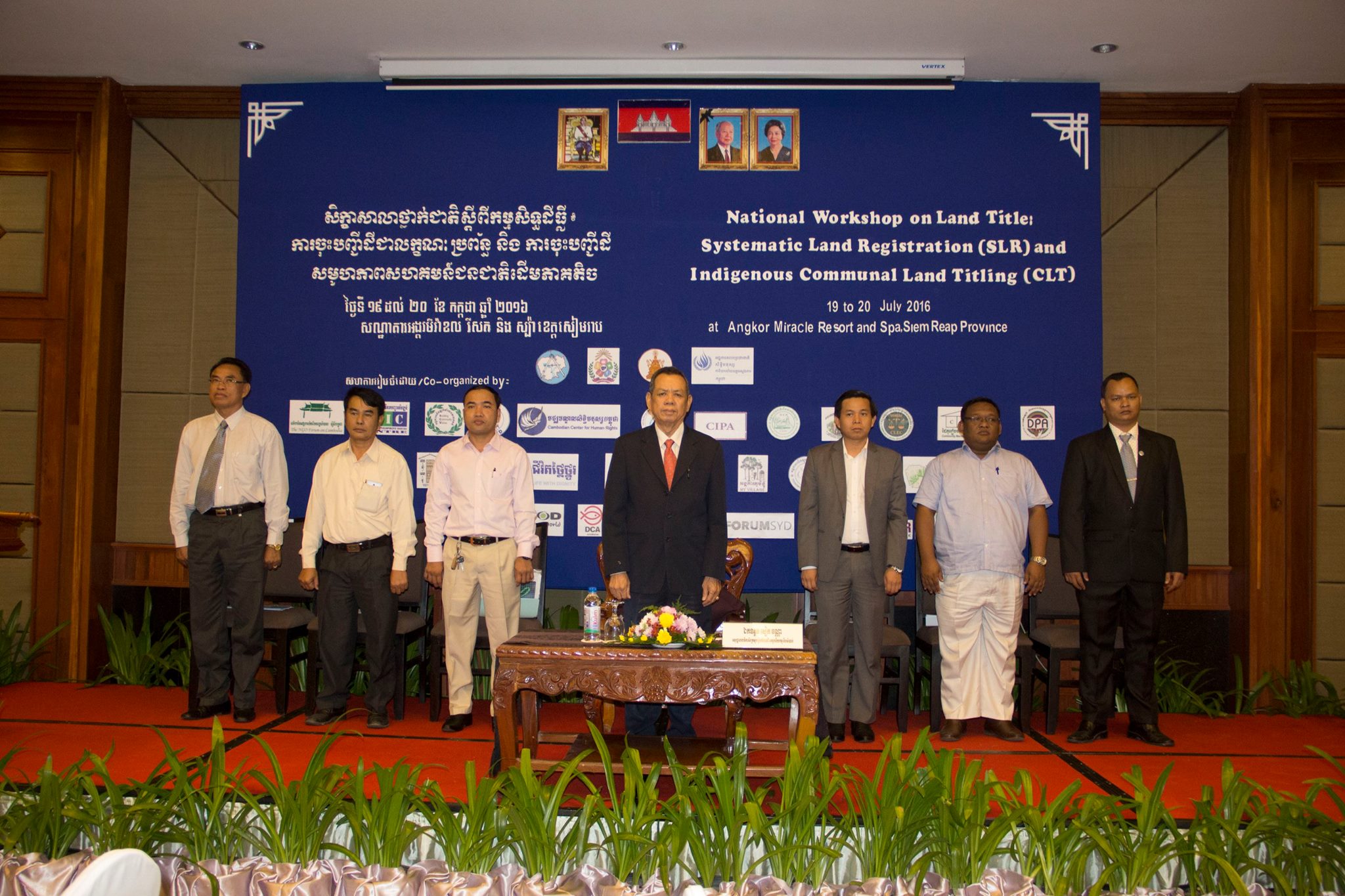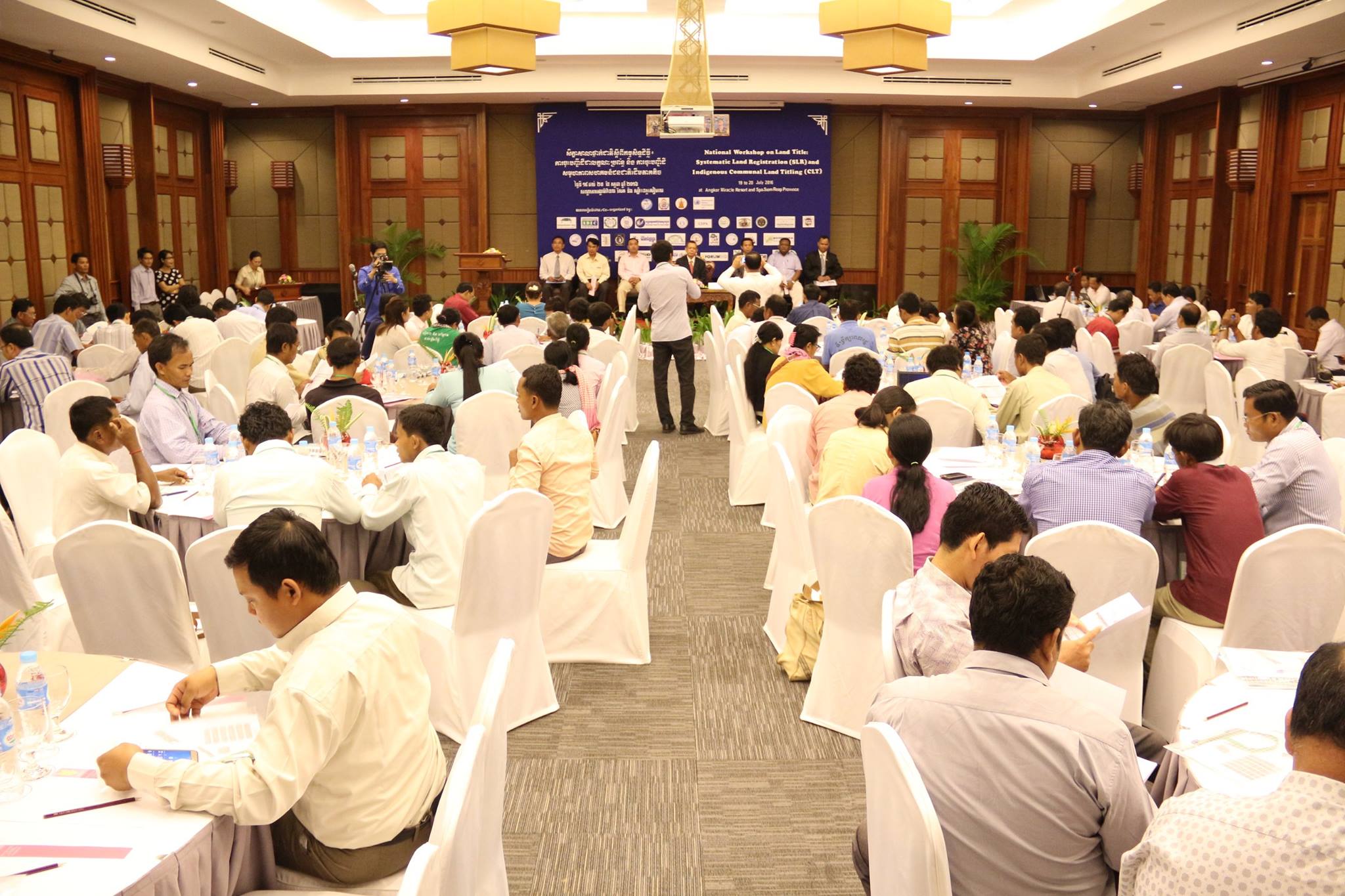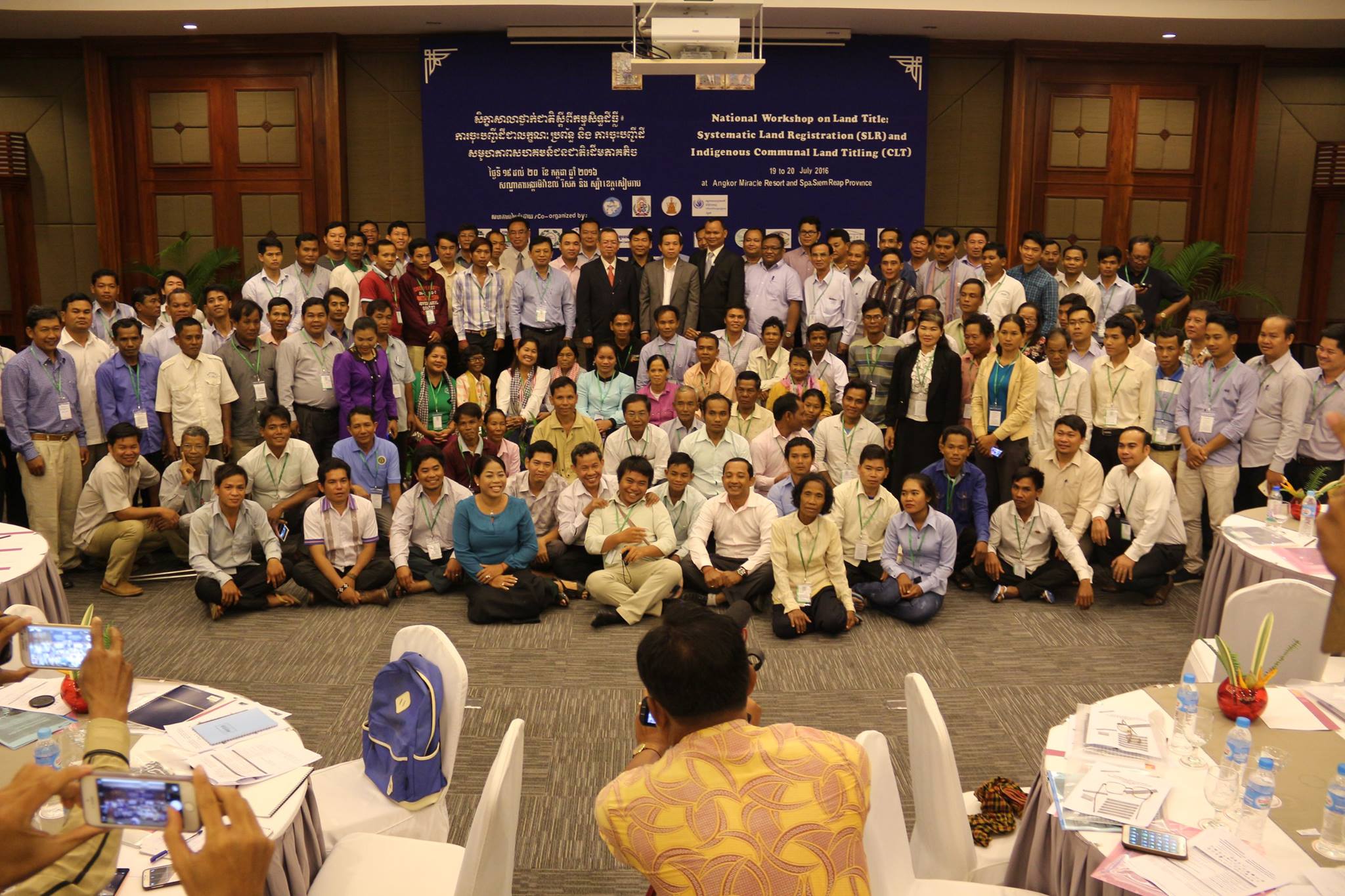
19-20 July 2016, Angkor Miracle Hotel, Siem Reap Province:
The NGO Forum on Cambodia (NGOF) in collaboration with relevant stakeholders organized a national workshop on Systematic Land Registration (SLR) and Indigenous Communal Land Titling (CLT). The two-day workshop brought over 140 active participants together in accordance with the planned agenda. The invited participants were representatives of civil society organizations, national and sub-national government officials, communities, researchers and academia.

The joint effort to address the land registration system is a contribution to the poverty alleviation of the Cambodian people, which is strongly supported and contained in the National Strategic Development Plan (NSDP). The proposed workshop focused on the special thematic “Together addressing the land and natural resources conflict through SLR and CLT” which was participated by NGOs, the government, communities, researchers and academia. The three objectives of the National Workshop were:
1. To open space for all relevant stakeholders including the government, development partners, academia, NGOs and communities to update the current status, raising concerns and challenges of SLR and CLT and in-depth discussion of technical solutions for speeding up or strengthening the technical processes of the land registrations.
2. To develop a very good national workshop report to be submitted to relevant ministries and stakeholders in order to push ahead the SLR and CLT processes.
3. To build a better cooperation among all stakeholders to improve the good governance on land and natural resources in contribution to the poverty alleviation of the RGC.
This national workshop is a significant event, giving opportunities to the government representatives, development partners, national and international civil society organizations, indigenous communities gathered together to discuss in a constructive manner and to look into the results of land registration, concerns, challenges that arise from the land registrations as well as to seek for joint strategies to achieve common objectives of land tenure security. It is noticed that there are many accomplishments achieved by the Royal Government of Cambodia (RGC) such as the development and implementation of laws, land policies and legal frameworks, fulfilling the responsibilities of relevant institutions at the national and sub-national levels and the results of land registration in 2015, of MLMUPC. However, there are still some challenges that led to delays in the land registrations.
Challenges related to the SLR are the limited participation of land occupants or the state institutions which are mandated to occupy the land; citizens’ lack of supported letters and documents to clarify as legal owners; slow land dispute resolution, the registration of private part of condominium, and limited participation in public display, e.g. in Pursat province, the public display was held at the police station which scared out citizens. Furthermore, the Directive 01 (D01) Land Registration did not implement the following of each step; and left out the dispute areas without registered. D01 provided opportunity to opportunists, affected indigenous communities’ land and did not allow for monitoring on the process of land registration, etc.
Challenges related to CLT are land disputes with private companies, ELCs, and some areas of National Protected Areas, state forest land. The individual ownership titles were the obstacles to process of communal land titling. Procedures of IP communal land titling are complex, especially related to required documentation for legal entity, preliminary map, limited number of technical officials, the delayed of issuance of interim protection measures.
Mr. Suon Sopha, Deputy Director General of Cadastral and Geography: Cambodia has two types of land registrations, First Registration and Subsequent Registration. The First Registration has two procedures: Procedure of SLR and Sporadic Land Registration. The Subsequent Registration is the registration on the changed ownership and registered parcel which changed the shape of the parcel, e.g. heritage, easements, sell and buy, divided parcel or joined parcels, etc. The procedure of Sporadic Land Registration can issue two kinds of title certificates, i) the ownership rights certificate and ii) the possession rights certificate.
The Procedure of SLR is implemented following the sub-decree #46 on the Procedures to establish Cadastral Index Map and Land Register. In June 9, 2016 RGC amended the sub-decree No. 46 of Article 6, Article 7, Article 11 which adjusted the period of notification and dissemination of SLR from 29 days to only 13 days and public display of adjudication record from 30 days to only 15 days. The procedure of SLR has 5 steps: 1. preparation, 2. technical operation, 3. public display of adjudication records, 4. decision making on the documents, and 5. issuing title.
H.E. Yim Chhong, Advisor to Council for Agricultural and Rural Development and as Director of Ethnic Minority Development: The self-identification of indigenous communities followed the Land Law 2001, national policy on the development of indigenous peoples, Sub-Decree #51 dated December 2001, and Circular # 0974 of MRD on July 2009. Self-identification of indigenous peoples’ communities is determined according to its criteria such as ethnicity, social, culture, tradition, traditional economy, land management and land use, and the willingness of the community. The MRD has faced some challenges such as geographic locations, time, support and resources.
Mr. Am Veasna, Deputy Director of the Department of Associations and Political Parties: The CLT has 3 steps: 1. Self-identification, 2. Legal Entity, and 3. Issuing of Titles. It is the responsibility of MRD, MOI and MLMPUC. The Office of Inter-Sectoral is responsible for the mechanism on the recognition of the legal entity of the community at the provincial level. At the national level, it’s the responsibility of the Department of Associations and Political Parties. The communities must meet certain conditions and formalities such as the list of community members, letters of recognition by MRD, by-law, community committee, a decision letter on the recognition of the by-law and a request letter for registration. The Ministry of Economic and Finance (MEF) and MOI have agreed in principle for excemtion of the fee amount to 300,000 Riels for the registration of legal entity.
Mr. Meas Bunthoeun, Deputy Director General of Cadastral and Geography: The general principle that applies to the CLT is the registration of pieces of land of a community as collective ownership on a single cadastral map. The collective ownership certificate, issued to the community, specifies the name and location of the community, reference number to the single cadastral map indicating the location, size, boundary, co-ordinates of the land plot collectively owned, and certification of the type of land use. The community has to be established as a legal entity with registered by-law and officially recognition. The community has to be officially established as legal entity which has internal rule stipulating the management and collective land use. Land to be registered as collective ownership of indigenous community (IP) includes state private land and state public land. State private land includes residential land and actual agriculture land. State public land includes reserved land for shifting cultivation, spiritual forest land which shall not exceed seven hectares, and burial ground forest land which shall not exceed seven hectares. As for other state land which IP has traditionally used such as forest land for harvesting non-timber forest products (NTFPs) and source for water, the community could continue to use and enjoy benefits according to its tradition given it shall enter into an agreement with relevant administrative authorities of state land.
Procedures and mechanism of the CLT has 5 steps: 1. Preparation (supported documents and application requesting for CLT), 2. Technical operation (state land identification, boundary demarcation and surveying), 3. Public display of the adjudication records, 4. The decision on the report of the public display, and 5. Issuance of titles. MLMUPC has faced some challenges such as:
• The communities take limited ownership in the processes
• Communities do not fully understand the procedure of preliminary mapping
• The dissemination, on procedures and advantages of the CLT, is not comprehensive
• The participation of communities, local authorities and relevant stakeholders is limited
• The communities are lack of financial and technical support after receiving titles
• The communities have no capacity to prevent and protect their land from encroachment.
